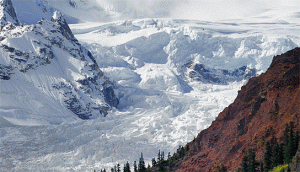Glaciers
By Michael FaginMt. Everest WeatherGlaciers and retreating glaciers is an important issue for mountaineers especially for Mt. Everest and the rest of the Himalaya. Also important to areas north and west of here into the Karakoram where K2 is found.
From the Sanksrit term “himalayah,” meaning “abode of snow,” the world’s most mountainous region houses 18,065 glaciers, leading to its nickname the “Third Pole.” Winter snowfall comes from the west to northwest as troughs of low pressure move in. Summer precipitation comes in from the Indian Ocean under the influence of the summer monsoon. This may see some of the highest precipitation totals especially for the eastern parts of the Himalaya.
The Karakoram
The glaciers of the Karakorams are different than European, North American and most other glaciers because of the abundance of high-altitude snows, available glacial replenishment mechanisms and conditions related to topology and verticality. Its glaciers are avalanche-fed, promoted by rocky cliff faces.
The Karakorams, 37% under permanent ice cover, house the largest concentration of glaciers in mainland Asia. 70% of the mountains are snow-covered, partially due to cooling from around 7,000 glaciers. The biggest fifteen support half the glaciated area. Eight are over 50 km long. Over twenty are 30+ km long. Maximum precipitation in the region occurs above 4,800 m. In total, there is 16,000 km2 of ice cover, with more than 80% between 4,000 and 5,500 meters.
Mt. Everest
Mt. Everest and areas to the east is more susceptible to monsoon precipitation and heavy precipitation compared to the K2 region. During the monsoon Everest region gets 70-85% of its precipitation. Much of that either freezes into glaciers or gets dammed by the terrain in warmer areas to create high altitude ponds and lakes. The Nepalese Himalaya alone house 3,252 glaciers and 2,323 lakes above 3,500 meters.
Nepal has one of the highest population densities with respect to cultivable land. Its agriculture, fed by glacial meltwater flowing from over 6,000 rivers and rivulets, is imperative to the livelihoods of locals. Recognizing the fragility of the equilibrium, the government of Tibet has responded by launching a 22 billion Yuan ecological improvement and protection plan, composed of 160 separate projects.

Glacier Himalaya
Glacial Retreat
Much of the concern of Nepal’s government surrounds the slow disappearance of most of their glaciers, seen there, the Karakoram and the Indian Himalaya alike. For example, India’s Gangotri glacier is retreating 23 m/yr, with the last three decades having been responsible for melting at 300% the previous rate.
The last glacial maximum, the last true ice age, peaked about 19,000 years ago and ended around 10,000 years ago. A minor cooling event called the Little Ice Age took shape just 700 years ago and peaked in the 15th Century. The change helped to rebuild some of the glacial losses since the last true ice age. Although the Little Ice Age is well known, less known is that it hung around at higher elevations, including the “Third Pole,” until the latter half of the 19th Century, when notable reductions in Asian glaciers began. A melting of 5%+ has been recorded since the early 20th Century. Glacial reduction was the trend until the 1970s, when it slowed and some localized growth occurred. The 1980s to late-90s warmed the region substantially, yielding copious melting. A stronger semblance of stability seemingly has settled since, with some new growth seen at high altitudes.
In general, more melting than growing is happening but both are very dependent on local microclimatic details. Topo-climates are determined by variations in slope, aspect and relative altitude. Changes to both snow cover and the terrain itself lead to the most microclimatic change. Glacial perimeters are exceptionally susceptible to change while providing the most compelling visual evidence of it. A dramatic scene there, however, is not always indicative of glacial reduction relative to possible changes higher up.
Impacts of Glacial Retreat
Glacial retreat yields climatic variation. It affects hydrology both locally and, if sea levels rise, globally. All of the countries in the region – namely Nepal, India, China, Pakistan and Bhutan – feel the effects.
Perhaps most important is downstream flooding, which can be dangerous but also typically easily embraced for agricultural purposes. The biggest downside is that there is only an abundance because the glaciers are disappearing, potentially too quickly to get replenished soon enough to avert future tragedies. The Karakoram largely drain into the Upper Indus basin, leading to the Indus River. Nepalese runoff runs through the Kosi, Narayani and Karnali rivers into India’s Ganges River.
Loosening ice, snow or terrain can lead to extra avalanches. Likewise, high-altitude glacial lakes can flood until the forces damming them grow overwhelmed, potentially leading to a warmer version of an avalanche – an intensely fast deluge pushing down a mountainside. Entire villages can get swept away by frigid water and debris, leading to thousands to millions of dollars in losses, as well as lives. Glacial lakes can appear and discharge within a matter of decades. For example, Nepal’s Imja Tsho at 5,000’ is about half the size of the largest glacial lake but appeared in the 1950s. Such dangers are most likely during warm years, when melting enhances lake volumes or separates and slicks icy layers in the snowpack. High wind and high precipitation weather events are most likely to trigger both avalanches and high-speed flooding from glacial lakes.
What will the climbing season and associated weather patterns be for Mt. Everest and K2? No one knows for now but it is critical for one to constantly analyze all the key forecast models and that is what we do.

Article writern by Meteroligst Goeff Linsley
Some of the content provided from this source and Glacier Retreat.
